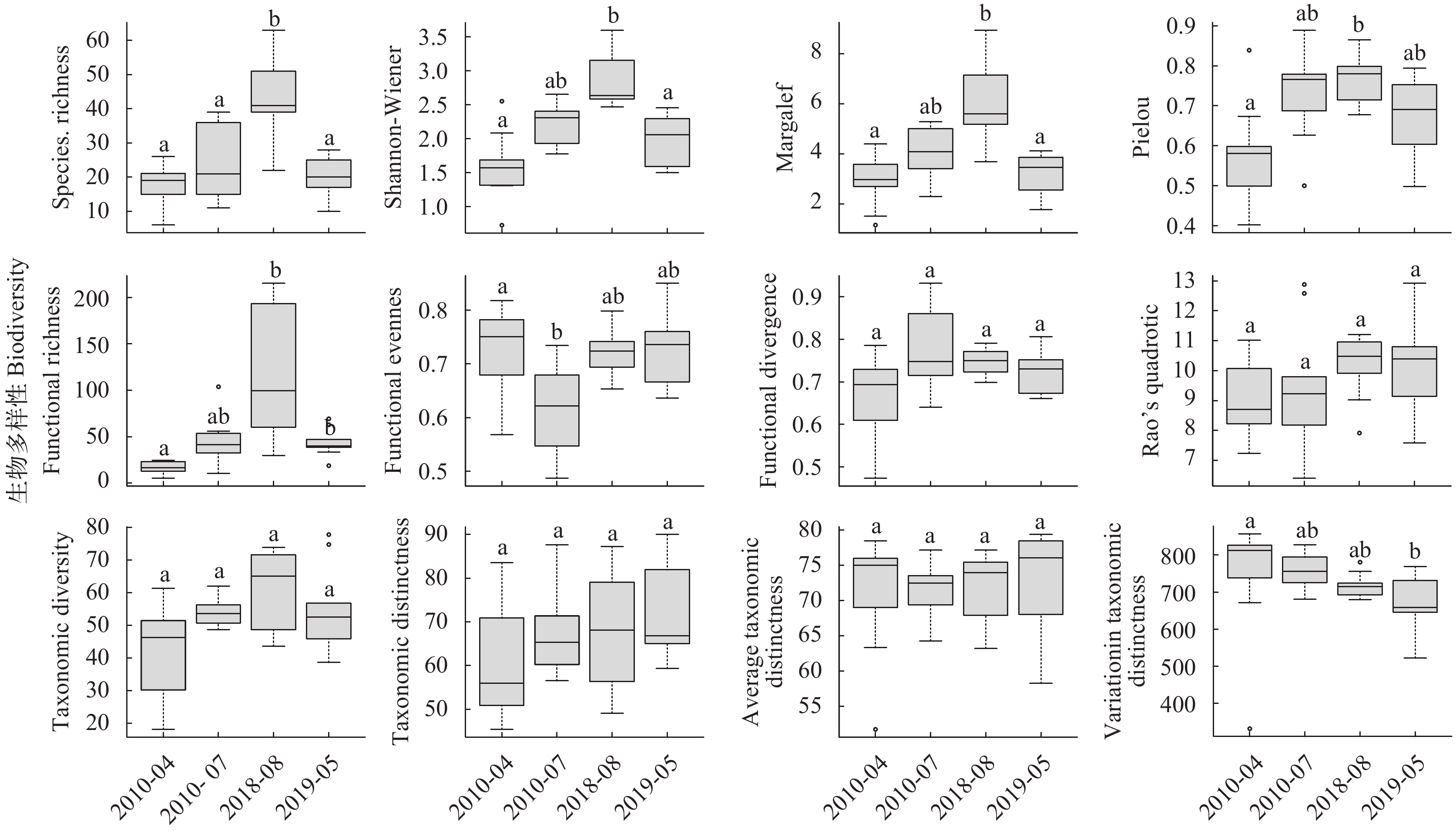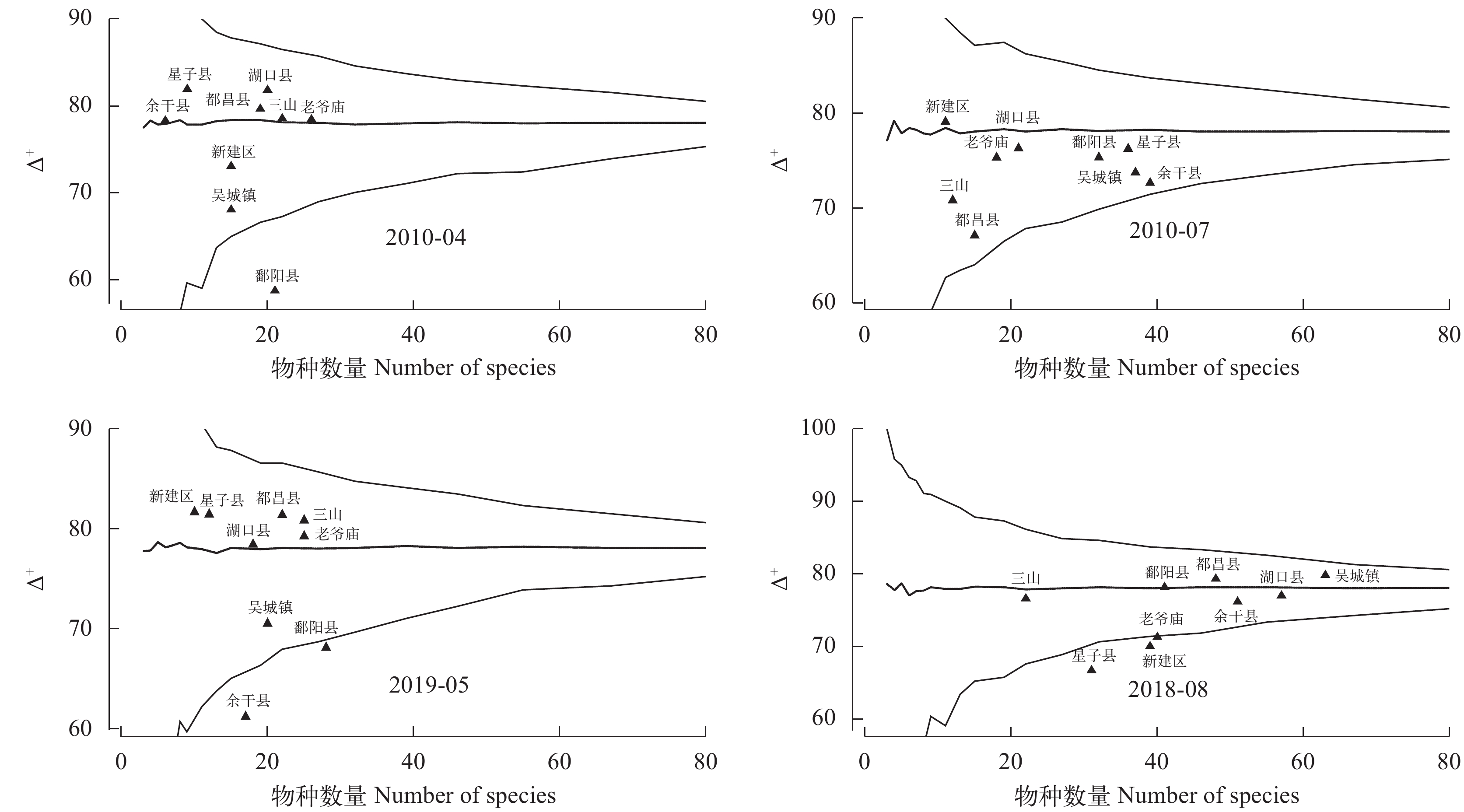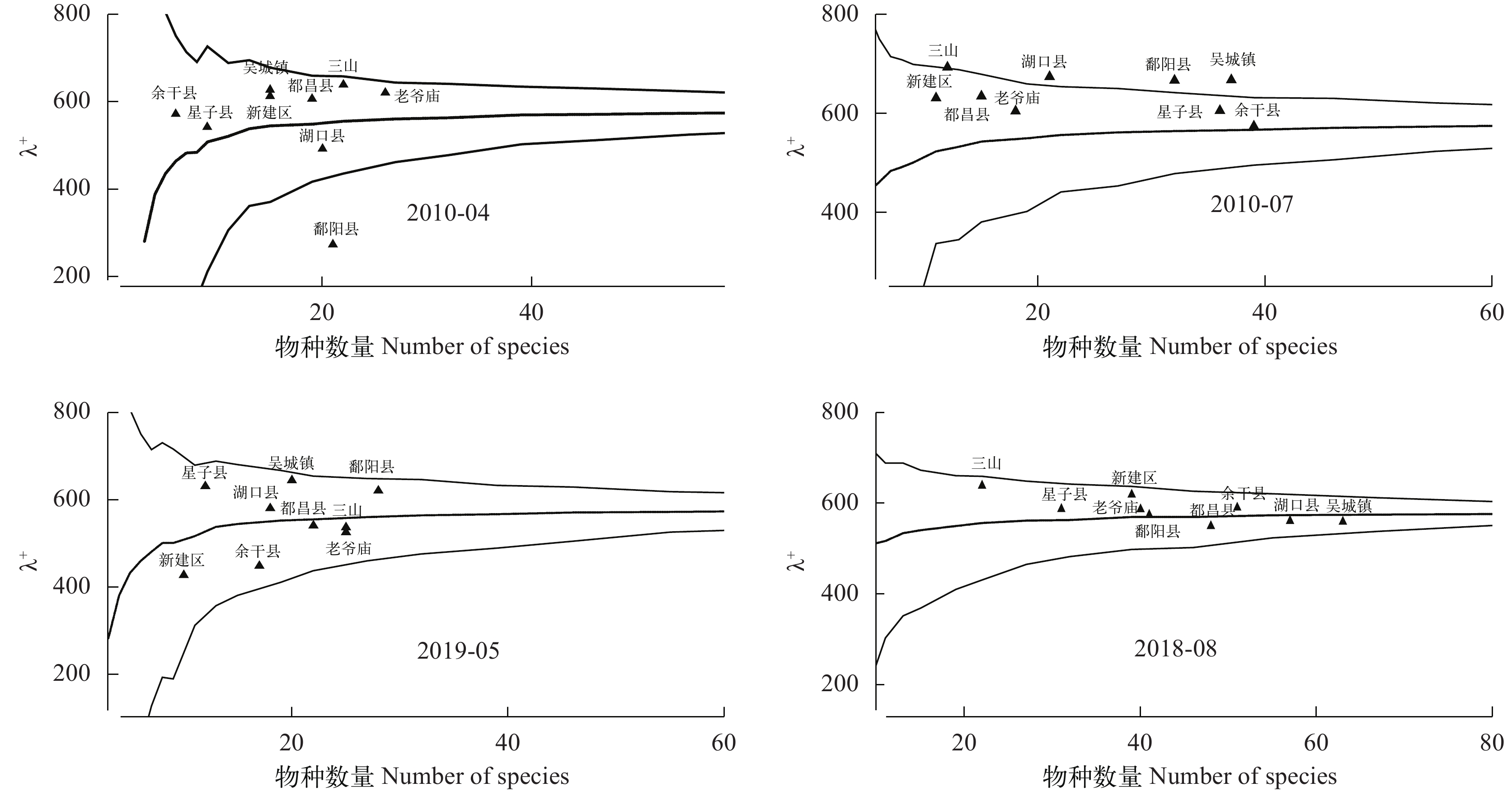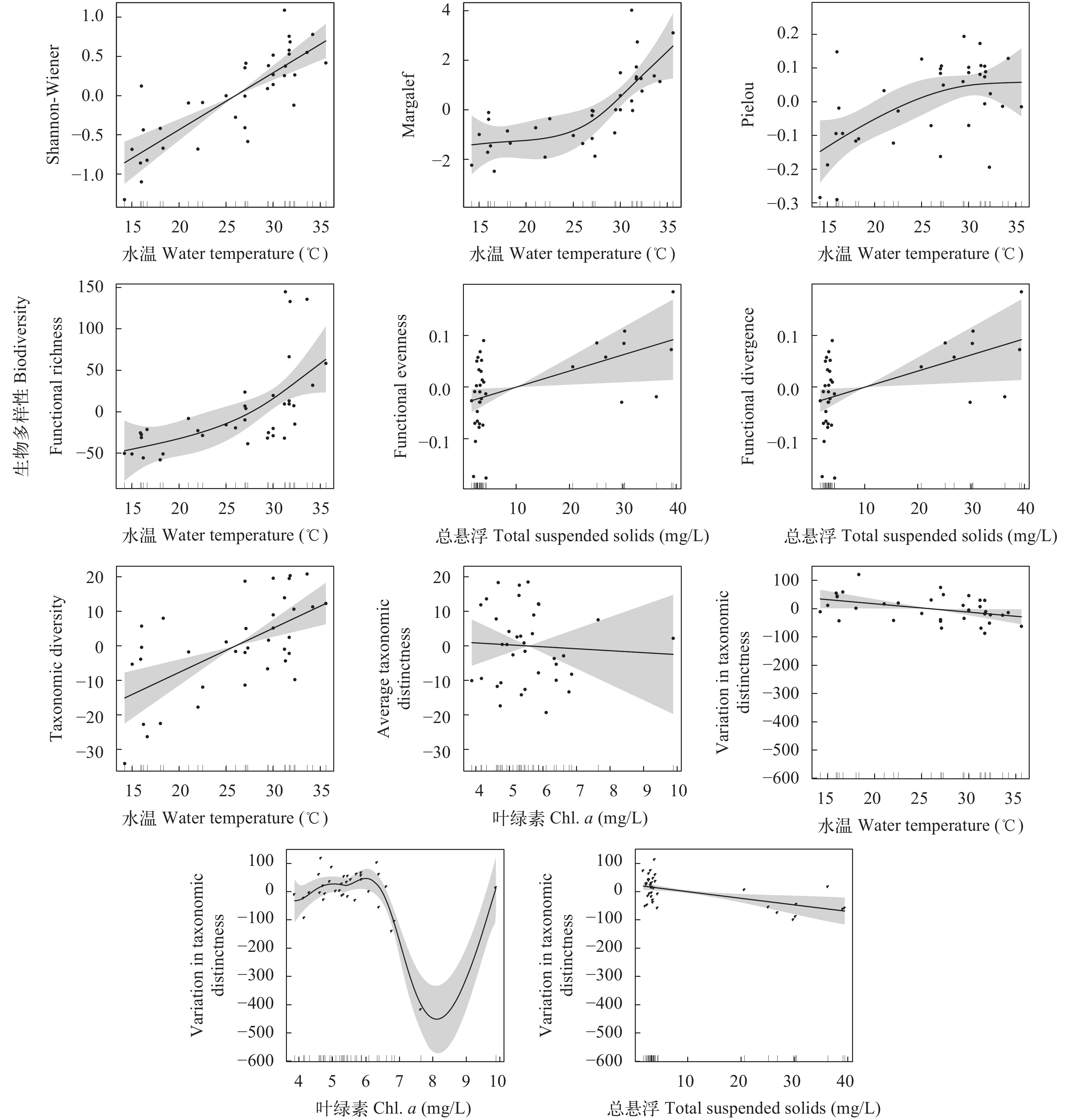TEMPORAL VARIATION OF FISH BIODIVERSITY IN POYANG LAKE
-
摘要: 研究基于2010年4月、7月和2018年8月、2019年5月在鄱阳湖9个区域的鱼类多样性调查数据, 分析鱼类物种多样性、功能多样性和分类差异指数的时空变化以及其与环境之间的关系, 了解鄱阳湖近十年来鱼类群落多样性的时空变化特征。结果显示, 2010年和2018—2019年分别调查到鱼类74种和93种, 群落结构差异显著(P<0.05), 差异贡献率最高的物种为短颌鲚、似鳊、鲫、光泽黄颡鱼和鲤; 水温、总悬浮物和叶绿素等环境因素具有显著的年际和季节差异(P<0.05)。与2010年相比, 2018—2019年鱼类物种多样性和功能多样性指数有一定增加, 分类差异指数没有显著变化。分类差异指数的随机检验显示(Randomization test), 与2010年相比, 2018—2019年位于95%概率置信范围下方的区域增加。水温、总悬浮物和叶绿素等环境因素对物种多样性、功能多样性和分类差异指数有显著的影响(P<0.05)。结果表明, 近十年来, 鄱阳湖鱼类群落结构发生明显改变, 但是小型鱼类依旧是优势种, 鱼类群落小型化明显, 主要原因可能是过度捕捞的影响。同时, 鄱阳湖的人类活动干扰增大, 鄱阳县、新建县和余干县等距离长江干流较远的区域人类活动干扰较大。长江十年禁渔的实施会对鄱阳湖鱼类资源恢复会起到明显作用。Abstract: Biodiversity serves as an important index in reflecting the impact of environmental changes on ecological communities. It is also essential in evaluating the health and integrity of ecosystems, providing insights into management and conservation initiatives. The river-lake complex ecosystem in the middle and lower Yangtze River are one of the most threatened areas subjected to anthropogenic activities. However, there is still a lack of research on taxonomic diversity and general understanding of fish community and diversity changes in the Poyang Lake over a long time span. Based on data derived from fish resources investigation in 9 regions of the Poyang Lake area in April and July 2010, August 2018 and May 2019, we analyzed the temporal changes of species diversity, functional diversity and taxonomic diversity of fish communities in the Poyang Lake as well as the relationship between biodiversity and environmental factors. The results showed that 74 and 93 species of fish were collected in 2010 and 2018—2019, respectively. There were significant differences in community structure, with Coilia brachygnathus, Pseudobrama simoni, Carassius auratus, Pelteobaggrus nitidus and Cyprinus carpio contributed the most variance. There were also significant differences in environmental factors between different years and seasons (P<0.05). Although the species diversity and functional diversity in 2018—2019 were higher than those in 2010, the variations in functional diversity and taxonomic distinctness (Λ+) were insignificant, suggesting the taxonomic range has narrowed albeit the fish species has increased in the past decade. The randomization test of the average taxonomic distinctness index (Δ+) and the variation in taxonomic distinctness (Λ+) showed that the number of sampling localities below the 95% probability confidence funnel from 2018 to 2019 increased compared with 2010, indicating that the degree of interference in the Poyang Lake area increased. The fish biodiversity in the Poyang Lake area was significantly correlated with water temperature, chlorophyll and total suspended solids concentration (P<0.05). The biodiversity of fish community was positively correlated with water temperature. However, the average taxonomic distinctness index (Δ+) and the variation in taxonomic distinctness (Λ+) were negatively correlated with the chlorophyll and total suspended solids. The results showed that the number of fish species in the Poyang Lake has increased under the periodic fishing ban of the Yangtze River, breeding and releasing project and ecological regulations. However, the small-sized fishes were still the dominant species in fish communities in the Poyang Lake during the past decade. This could be attributed to over-exploitation. Besides, anthropogenic disturbance compromised habitat heterogeneity. In particular, regions that located far from the Yangtze mainstream like the Poyang county, Xinjian county and Yugan county were more impacted by human activities. In order to protect and restore fish diversity in the Poyang Lake as well as the flood plain habitats in the middle and lower reaches of the Yangtze River, we suggest to take a series of measures in complementary to the ten-year fishing ban, such as demolition of small hydro power plants, reduction of reclamation and restoration of natural habitats.
-
淡水生态系统是人类活动干扰最严重的区域之一[1, 2]。捕捞、水利水电工程建设、栖息地破碎化、生境退化和水环境污染等问题日益严重, 加速了淡水水体的生物多样性减少[3-8]。生物多样性是影响生态系统稳定性(Ecosystem stability)及服务与功能(Ecosystem service and functioning)的重要因素[9-11], 近年来已经成为反映环境变化对生物群落结构影响、评估生态系统完整性和健康的重要指标[12, 13], 也是制定水生生态系统管理和保护政策的科学依据之一。
目前, 生物多样性研究主要包括物种多样性、功能多样性和系统发育多样性等三个方面内容。物种多样性主要是反映群落中物种数量及均匀度的特征和变化, 但不能提供物种的形态和性状特征、生态功能、系统进化等方面的信息, 对于进一步分析生态系统服务和功能及稳定性的作用有限。因此, 在考虑生态功能特征和进化的情况下, 生态学家们提出了功能多样性指数和系统发育多样性指数。Tilman等[14]提出功能多样性的概论, 即影响生态系统功能的物种性状的数值、范围及分布。功能多样性指数主要是分析物种性状的数量、范围及均匀度, 了解物种的性状特征与生态系统功能及服务之间的关系, 以及其对环境改变的响应, 是研究生态系统结构与功能及修复措施的方法之一[15, 16]。Faith[17]首次提出系统发育多样性的定义, 用于评估某一区域物种组成的系统进化特征, 分类差异指数是系统发育多样性主要指数之一[18], 是从物种进化单元的角度分析群落差异的多样性指数, 可用于评价人类活动对群落的干扰程度[13, 19-21]。这3种多样性指数反映生物群落对环境变化在不同维度的响应[22-24], 其综合分析已经成为研究生物多样性演变机制的主要方法之一[25, 26]。
鄱阳湖是中国第一大淡水湖, 是长江中下游仅存的3个通江湖泊之一, 流域面积可达16.4×104 km2, 占长江流域面积的9%。鄱阳湖的水文情势受长江和五河(赣江、抚河、修河、信江和饶河)的影响, 季节水位变化差异显著, 丰水期的水域面积可达4070 km2, 枯水期的水位可低至1000 km2[27]。鄱阳湖是长江中下游复合生态系统的重要组成部分, 为长江鱼类提供重要的栖息地、产卵场和索饵场, 对维持长江中下游流域的水生生物多样性及生态系统结构与功能起到了重要的作用[28-32]。但是, 社会经济发展和人类活动的影响已经造成鄱阳湖水生生态系统发生显著变化, 例如鱼类资源减少[33], 同质化程度增加[34]、水面面积减小[35]、水环境污染加剧[36]和植被退化[37]。本研究通过2010年和2018—2019年在鄱阳湖湖区的鱼类资源调查, 分析鄱阳湖鱼类物种多样性、功能多样性和分类差异指数的时空变化, 以及环境变化对鱼类多样性的影响, 为了解鄱阳湖鱼类多样性时空变化特征, 开展鱼类多样性保护工作提供科学依据。
1. 材料与方法
1.1 样本采集
2010年4月、7月、2018年8月和2019年5月于鄱阳湖湖区开展鱼类资源调查(N29°45′48″—28°49′08″, E116°13′50″—116°22′40″), 因季节水位差异及采样条件限制, 采样点有所差异, 故设置9个采样区域(E1—E9; E1: 湖口县, E2: 星子县, E3: 吴城镇, E4: 老爷庙, E5: 都昌县, E6: 三山, E7: 鄱阳县, E8: 新建县, E9: 余干县; 图 1)。调查网具包括定置刺网、虾笼(地笼)、网簖和拖网。定置刺网的网目为3—6 cm, 采样时间为晚上10—12点到次日早上4—6点。虾笼(地笼)的网目为0.6—3 cm, 采样时间为晚上8—10点到次日早上4—6点。网簖的采样时间为24h。拖网每个区域进行3—4次采样, 每次采样距离约500 m。每个调查月份开展1次调查, 每次调查在每个区域进行2d采样。采样的鱼类样本送回野外临时实验室, 鉴定鱼的种类, 记录每个种类的数量, 测量每尾鱼类的体长(精确到1 mm)、体重(精确到0.1 g)。
1.2 环境变量
在采样点使用手持式分析仪测量水温, 使用透明度盘测量透明度, 采用无云 MODIS 2010年、2018年和2019年影像数据结合实地采样数据完成鄱阳湖水色参数遥感反演, 并对结果进行季度合成来获得鄱阳湖水体叶绿素及和总沉淀物数据。叶绿素 a 浓度反演模型: Chl.a=26.606×Exp(–4.093X), X=Red/(Nir_Red+Blue+Green)[38]。悬浮物浓度反演模型: SPM=86236.23Rrs(645)3–15858.70 Rrs(645)2+1005.29 Rrs(645)–15.67[39]。
1.3 数据分析
群落空间结构分析 利用置换多元方差分析(Permutational multivariate analysis of variance, PERMANOVA), 分析2010年和2018—2019年鄱阳湖鱼类群落结构的差异。以Bray-Curtis相似性系数为基础构建2010年和2018—2019年鄱阳湖各位点相似性矩阵, 采用非度量多维标度排序方法(Non-metric multidimensional scaling, NMDS)分析鄱阳湖鱼类群落空间结构特征。利用胁强系数(Stress)判断NMDS图的优劣情况。通常0<stress<0.01表示完全可信; 0.01<stress<0.05表示可信的; 0.05<stress<0.1表示基本可信; 0.1<stress<0.2, 表示具有一定参考意义[40]。
通过相似性分析(Analysis of similarities, ANOSIM)检验不同分组间的差异显著性, 其中组间差异用R来表示, R通常为0—1, R=0时, 代表组间无差异, R=1时, 代表组间所有区域间的差异性大于组内任意区域间[40]。通过相似性百分比程序法(Similarity percentage procedure, SIMPER), 分析导致2010年和2018—2019间群落差异的物种及其贡献度[41]。
群落结构分析PERMANOVA、NMDS、ANOSIM和SIMPER使用统计软件PAST和Primer 6完成。
多样性指数 物种多样性(Taxonomic diversity index) 采用以下多样性指数评价鄱阳湖鱼类物种多样性情况。
Species richness物种丰富度指数: S
Shannon-Wiener多样性指数: H′=–∑PilnPi
Margalef丰富度指数: D=(S–1)/lnN
Pielou均匀度指数: J′=H′/lnS
式中, S为取样的物种总数, N为取样总数, Pi为第i种物种占总尾数的比例。
功能多样性(Functional diversity index) 功能性状指通过对生长、繁殖和存活的影响, 间接影响物种适应性的形态生理物候特征, 可以反映物种对环境和生态过程的响应[42]。本研究依据鄱阳湖环境特点, 选取形态、生境、营养水平和生活史等4个类别, 包括12个功能性状[43]。表 1中的功能性状数据来自fishbase网站(www.fishbase.org)和已发表的文献或书籍[44]。
表 1 鄱阳湖鱼类的功能性状参数Table 1. Fish functional traits in the Poyang lake类别
Category功能性状
Functional traits单位/描述
Unit/Description形态
Morphology体型 体长(cm)/体高(cm) 体长/尾柄长 最大体长 cm 相对眼径 头长(cm)/眼径(cm) 口位 上位、端位、下位 生境
Habitat垂直分布 底栖、中下层、中上层 流速喜好 流水型、静水型、广适型 洄游类型 洄游型、湖泊定居型、河流型 营养水平
Trophic level食性 植食性、鱼食性、杂食性 、浮游生物食性、底栖无脊椎食性、碎屑食性 生活史
Life history寿命 鱼类最大存活时间(年) 初次性成熟时间 鱼类繁殖的最初时间 产卵类型 漂流性卵、黏性卵、筑巢产卵、于贝类中产卵 产卵量 鱼类一次繁殖期产卵的数量 功能多样性指数包括功能丰富度指数(Functional richness, FRic)、功能均匀度指数(Functional evenness, FEve)、功能离散度(Functional divergence, FDiv)、Rao二次熵指数(Rao’s quadratic diversity, RaoQ)。
功能丰富度指数(FRic): 表示物种所占生态位的多少。
$ {\text{FRic}} = \int_i^{\max } [f_i(x)]dx \qquad\qquad\qquad\quad$


$ f_i(x) = \exp [ - \frac{1}{2}{(x - u_i)^T}\sum\nolimits_i^{ - 1} {(x - u_i)} ] $


式中, x为性状值, i为物种, ui为物种i的平均性状值, ∑i为每个物种性状的方差/协方差矩阵, fi(x)为群落中所有物种性状空间的从属函数[45]。
功能均匀度指数(FEve): 表示群落内物种功能性状的丰度在多维性状空间分布情况。
$ PEW_L = \frac{1}{{\sum\limits_{S - 1} {\sum\limits_{J = 2}^{S - 1} {\frac{{{\text{di}}st(i,j)}}{{{\omega _i} + {\omega _j}}}} } }} \times \displaystyle\frac{{dist(i,j)}}{{{\omega _i} + {\omega _j}}}\;\;\; $


$ {\text{FEve}} = \frac{{\sum\limits_{i = 1} {\min (PE{W_L} \times \frac{1}{{S - 1}}) - \frac{1}{{S - 1}}} }}{{1 - \frac{1}{{S - 1}}}} $


式中, S为物种数, ωi、ωj为物种i、j的相对丰富度, dist(i, j)为物种间的欧式距离。L为分支长, PEWL为分支长权重。
功能离散度(FDiv): 功能性状与性状空间的离散程度。
$ \mathrm{FDiv} = \frac{\Delta d + \overline{d \vec{G}}}{\Delta|d| + \overline{d \vec{G}}} \qquad\qquad\;\;$


$ \Delta d= \sum_{i=1}^{S} \omega_{i} \times \left(d G_{i}-\overline{d G}\right) \qquad$


$ \overline{d G}= \frac{1}{s} \sum_{i=1}^{s} d G_{i} \qquad\qquad\qquad\;$


$ \Delta \left| d \right| = \sum\nolimits_{i = 1}^S {{\omega _i} \times \left| {d{G_i} - \overline {dG} } \right|} $


式中, S为物种数, ωi为物种i的相对丰度, dGi为物种i的性状值到性状空间质心的距离[40]。
Rao二次熵指数(RaoQ): 表示物种距离的变异。
$ RaoQ = \sum\limits_{i = 1}^S {\sum\limits_{j > i}^S {d_{ij}} } {P_i}{P_j} $


式中, Pi和Pj分别表示物种i和物种j的相对丰度, S为物种数, dij表示物种i与物种j之间的距离。以上功能多样性通过R语言FD包进行计算。
分类差异指数(Taxonomic distinctness index) 根据纳尔逊分类系统[46]建立鄱阳湖鱼类名录, 通过种类丰度数据计算分类多样性。本文采用以下4个分类差异性指数: 分类多样性指数(Taxonomic diversity, Δ)、分类差异指数(Taxonomic distinctness, Δ*)、平均分类差异性指数(Average taxonomic distinctness, Δ+) 和分类差异变异指数(Variation in taxonomic distinctness, Λ+ )。
分类多样性指数(Δ): 任意两个物种间在系统发育分类树状图中平均的路径长度。
$ \Delta = \frac{{\sum {\sum\nolimits_{i < j} {{\omega _{ij}}{X_j}{X_i}} } }}{{\sum {\sum\nolimits_{i < j} {{X_j}{X_i} + \sum\nolimits_i {{X_i}({X_i} - 1)/2} } } }} $


分类差异指数(Δ*): 与 Δ 相似, 只是在计算个体间平均路径长度时, 忽略相同物种个体之间路径的长度。
$ \Delta^{*}=\frac{\sum \sum_{i < j} \omega_{i j} X_{j} X_{i}}{\sum \sum_{i <j} X_{j} X_{i}} $


平均分类差异指数(Δ+): 物种名录中任意一对物种之间的平均分类距离路径长度, 不考虑物种丰度。
$ {\Delta ^ + } = \frac{{\sum {\sum\nolimits_{i < j} {{\omega _{ij}}} } }}{{S(S - 1)/2}} $


分类差异变异指数(Λ+): 与 Δ+偏离程度的理论平均值, 表示每对路径长度的变异性。
$ {\Lambda ^ + } = \frac{{\sum {\sum\nolimits_{i < j} {{{({\omega _{ij}} - {\Delta ^ + })}^2}} } }}{{S(S - 1)/2}} $


式中, S表示群落中的物种数目, ωij表示物种i和物种j在分类系统树状图的路径长度, Xi和Xj分别表示物种i和物种j的丰度。
使用随机检验(Randomization test)分析在95%置信区间中平均分类差异性指数(Δ+)和分类差异变异指数(Λ+)观测值与期望值的偏差, 上式分类多样性指数通过R语言vegan包计算得到, 随机检验运用统计软件Primer 6的TAXDTEST功能计算。
环境对多样性指数的影响 利用单因素方差分析方法(One-way analysis of variance)分析年度间相同月份和年度内不同月份的环境参数差异。利用非参数检验及多重分析比较(Kruskal-Wallis analysis of variance followed by the Mann-Whitney post hoc test)分析年度间相同月份和年度内不同月份的多样性指数(4个物种多样性指数, 4个功能多样性指数和4个分类差异指数)的差异。利用广义加性模型分析(Generalized additive model, GAM)多样性指数与环境参数的关系。单因素方差分析方法、非参数检验及多重分析比较和皮尔森相关系数分析用SPSS19.0软件完成, 广义加性模型通过R软件的mgcv程序包完成[47]。
2. 结果
2.1 种类组成
2010年5月和7月采集到鱼类7635尾, 约443 kg, 隶属于6目13科48属74种。其中, 鲤科鱼类占比最高, 共46种, 约62.1%; 其次为鲿科鱼类, 共7种, 约9.4%。数量上占优势的分别是鲫(Carassius auratus)、鲤(Cyprinus carpio)、蛇(Saurogobio dabryi)、光泽黄颡鱼(Pelteobaggrus nitidus)和光唇蛇(Saurogobio gymnocheilus), 共占总尾数的60.7%。
2018年8月和2019年5月采集到鱼类16524尾, 约1094 kg, 隶属于6目14科57属93种。其中, 鲤科鱼类占比最高, 共52种, 约55.9%; 其次为鲿科鱼类, 共14种, 约15.0%。数量上占优势的分别是似鳊(Pseudobrama simoni)、短颌鲚(Coilia brachygnathus)、鲫、䱗(Hemiculter leucisculus)和翘嘴鲌(Culter alburnus), 共占总尾数的37.2%。
2.2 群落结构变化
2010年和2018—2019年的鱼类群落结构差异显著(P<0.05)。SIMPER分析结果显示, 2010年和2018—2019年间, 18个物种共贡献70.14%的群落差异(表 2), 贡献率最高的物种为短颌鲚、似鳊、鲫、光泽黄颡鱼和鲤。
表 2 2010年与2018—2019年鱼类群落结构差异的主要影响物种Table 2. The fish species mainly contributed to the dissimilarity of the fish assemblage structures in the Poyang Lake between 2010 and 2018—2019种类
Species对差异的贡献
Contribution to dissimilarity贡献率
Contribution
(%)累积贡献率
Cumulative
(%)短颌鲚Coilia brachygnathus 8.51 8.51 似鳊Pseudobrama simoni 8.26 16.77 鲫Carassius auratus 7.32 24.09 光泽黄颡鱼Pelteobaggrus nitidus 5.03 29.12 鲤Cyprinus carpio 4.7 33.82 蛇Saurogobio dabryi 4.63 38.45 翘嘴鲌Culter alburnus 3.5 41.95 䱗Hemiculter leucisculus 3.43 45.38 短须鱊Acheilognathus barbatulus 3.07 48.45 光唇蛇Saurogobio gymnocheilus 2.88 51.33 大鳍鱊Acheilognathus macropterus 2.79 54.12 鲂Megalobrama skolkovii 2.77 56.89 贝氏䱗Hemiculter bleekeri 2.59 59.48 麦穗鱼Pseudorasbora parva 2.54 62.02 蒙古鲌Chanodichthys mongolicus 2.18 64.2 银鲴Xenocypris macrolepis 2.16 66.36 高体鳑鲏Rhodeus ocellatus 1.91 68.26 鲇Silurus asotus 1.88 70.14 等级聚类和非度量多维尺度分析(NMDS)结果显示, 2010年4月和7月鄱阳湖鱼类群落可以分为三组。第一组为都昌县、老爷庙和三山, 主湖区聚为一组, 第二组包括星子县、吴城镇、鄱阳县和余干县, 第三组湖口县或湖口县和新建区单独聚为一组。2018年8月和2019年5月, 聚类为三组, 第一组包括大部分区域, 2010年8月, 仅都昌县与三山, 星子县分别分为一组, 2019年5月, 湖口县、老爷庙分别单独分为一组。ANOSM显著性检验结果显示, 表明4个时期的3个聚群均存在显著性差异(P<0.05; 图 2)。
2.3 多样性变化
多样性指数分析结果显示, 2018年8月的物种丰富度指数、功能丰富度指数(FRic)最大, 2019年5月平均分类差异指数(Δ+)最大; 2010年4月的功能均匀度指数(FEve)最大, 2010年7月功能离散度指数(FDiv)和分类差异变异指数(Λ+)最大。2010年7月功能均匀度指数(FEve)最小, 2019年5月分类差异变异指数(Λ+)最小, 其他多样性指数在2010年4月最小。总体上, 年际间, 2018—2019年的多样性指数较2010年高; 季节间, 7—8月份高于4—5月份。物种多样性指数和功能丰富度指数在2010年4月和2018年8月之间存在显著差异(P<0.05), 物种丰富度指数、Shannon指数和Margalef指数在2018年8月和2019年5月之间存在显著差异(P<0.05), 功能均匀度指数在2010年4月和2010年7月之间存在显著差异(P<0.05), 平均分类差异指数在2010年4月2019年5月之间存在显著差异(P<0.05), 其余没有显著差异(P>0.05; 图 3)。
平均分类差异性指数(Δ+)的随机检验(Randomization test)结果显示, 2010年4月, 大多数区域处于95%概率置信范围内且大于理论平均值, 仅鄱阳县位于置信范围下方, 2010年7月, 所有区域均处于95%概率置信范围内, 但大多数小于理论平均值, 仅新建区大于平均值, 2018年8月新建区和星子县处于置信区域下方, 2019年5月余干县和鄱阳县处于置信区间下方(图 4)。
![]() 图 4 鄱阳湖不同季度鱼类群落平均分类差异性指数的随机化检验中心线是总物种列表的平均值。漏斗线是95%模拟值的置信区间; 下同Figure 4. The changes of the average taxonomic distinctness of fish assemblages in the sampling area of Poyang Lake are analyzed by the randomization testCentral line is the mean value for the total species list. Funnel line is confidence limits within which 95% of simulated values lie. The same applies below
图 4 鄱阳湖不同季度鱼类群落平均分类差异性指数的随机化检验中心线是总物种列表的平均值。漏斗线是95%模拟值的置信区间; 下同Figure 4. The changes of the average taxonomic distinctness of fish assemblages in the sampling area of Poyang Lake are analyzed by the randomization testCentral line is the mean value for the total species list. Funnel line is confidence limits within which 95% of simulated values lie. The same applies below分类差异变异指数(Λ+)的随机检验(Randomization test)结果显示, 2010年4月, 大多数区域处于95%概率置信漏斗范围内且大于理论平均值, 仅鄱阳县位于置信漏斗下方, 2010年7月, 湖口县、鄱阳县和吴城镇位于置信漏斗上方, 2018年8月, 所有区域均处于95%概率置信漏斗范围内, 大部分区域大于理论平均值, 都昌县、湖口县和吴城镇的分类差异变异指数(Λ+)小于平均值, 2019年大多数区域处于95%概率置信漏斗范围内且大于理论平均值, 余干县和鄱阳县位于置信漏斗下方(图 5)。
2.4 环境因子
单因素方差检验结果显示, 环境因素具有显著的年际和季节差异, 水温在不同年度, 不同季节均具显著差异, 其中2018—2019年高于2010年, 7—8月高于4月; 透明度2010年7月显著高于其他季度; 叶绿素浓度2018年8月显著低于2010年7月和2019年5月; 总悬浮物2010年7月显著低于其他季度(表 3)。
表 3 鄱阳湖不同季度环境因素比较Table 3. The environmental factors at the different seasons in Poyang Lake环境参数Environmental factors 2010年4月
April 20102010年7月
July 20102018年8月
August 20182019年5月
May 2019水温 Water temperature (℃) 16.2±1.3a 30.1±1.9b 32.3±1.9c 25.0±2.9d 透明度 Transparency (cm) 52.1±17.9a 88.6±25.2b 47.7±23.1a 56.7±29.6a 叶绿素 Chl. a (mg/L) 5.5±1.0ab 5.7±0.7b 4.7±0.6a 6.3±1.5b 总悬浮物 Total suspended matter (mg/L) 35.6±3.1a 24.9±2.3b 35.6±3.1a 31.7±4.4c 注: 表中数据为环境指数的平均值(P<0.05)。a和 b表示存在显著差异, a和ab、b和ab之间表示不存在显著差异Note: Data are the means of environmental index. The different superscript letters in the upper right corner of the same row show significantly difference between the data (P<0.05) 2.5 多样性指数与环境关系
广义加性模型(GAM)分析结果显示, Shannon指数、Margalef指数、Pielou指数、功能丰富度指数(FRic)和分类多样性(Δ)均与水温显著相关(P<0.05), 功能均匀度FEve和功能离散度FDiv与总悬浮物浓度显著相关(P<0.05), 分类差异指数(Δ*)与叶绿素浓度显著相关(P<0.05), 平均分类差异性指数(Δ+)和水温、叶绿素及总悬浮物浓度显著相关(P<0.05; 图 6)。
3. 讨论
3.1 鄱阳湖鱼类多样性的时空变化特征
本研究结果显示, 近十年来, 鄱阳湖湖区鱼类群落结构发生明显变化。短颌鲚、似鳊、䱗等小型喜静水鱼类资源增加是造成鄱阳湖湖区鱼类群落结构发生明显差异的主要原因。尽管近年来随着人工放流四大家鱼亲鱼、生态调度等保护措施的实施, 长江中游江段以四大家鱼等为代表的产漂流性卵鱼类的产卵规模明显增加[48-50], 但是2010年和2018—2019年鄱阳湖的鱼类群落均以小型鱼类为主。小型化是人类活动对鱼类资源的主要影响之一。近20年来, 长江干流[51]、鄱阳湖[52]、洞庭湖[53]、太湖[54]和呼伦湖[55]等水域的鱼类都出现明显的小型化趋势。过度捕捞是造成鄱阳湖鱼类小型化的主要原因之一[33]。
调查期间, 鄱阳湖湖区鱼类群落的物种和功能丰富度指数均增加, 但是功能多样性总体变化不明显。群落的功能性状数量与种类数量和组成有关, 如果没有功能冗余, 那么物种和功能丰富度指数呈正相关[3, 4, 56]。虽然调查期间鄱阳湖鱼类群落增加的主要是小型喜静水鱼类, 但是它们之间及与已有物种之间的性状特征可能没有太多重叠, 因此没有表现出明显的功能冗余。虽然鱼类种数增加, 但是分类差异指数没有明显变化, 表明分类单元和物种之间亲缘关系变化不明显, 而近缘种增加。因此, 综合3类多样性指数的结果分析, 近十年来, 鄱阳湖湖区鱼类群落增加了一些小型鱼类的近缘种, 它们具有不同的性状特征, 与已有的种类相比占据不同的生态位, 可以利用不同的资源和空间, 因此没有形成明显的功能冗余。
近年来, 分类差异指数还被广泛地应用于评估环境干扰。分类差异指数对于采样规模和范围不敏感, 因此可用于不同时期、地点的数据比较[57]。而且, 当区域发生环境退化时, 物种较少的分类群会率先消失, 导致该分类差异指数下降, 因此可以用于评估环境的干扰程度。已有研究发现, 物种多样性与分类差异指数的变化趋势不一致[3], 分类差异指数对环境干扰更敏感[56]。本研究的结果显示, 近十年来鄱阳湖人类活动干扰增大, 尤其是鄱阳县、新建县和余干县等距离长江干流较远的区域人类活动干扰最为明显。已有研究结果显示, 人类活动造成的土地利用增加对鱼类多样性有显著的影响[58]。近10年来, 江西省社会和经济快速发展, 2010年至2019年, 江西省人口增加了209万, GDP增加了15322亿元, 人类活动明显增大。鄱阳湖周边水产养殖、农业、生活污水的排放造成鄱阳湖富营养化日益加重[59—61], 围垦、长江干流和鄱阳湖支流水利工程建设和运行、采砂活动则改变鄱阳湖鱼类栖息地物理和水文特征[34, 36, 62]。
鄱阳湖鱼类物种多样性和功能多样性指数有明显的季节差异。鄱阳湖鱼类种类变化可能与水位和气温的变化相关[30]。鄱阳湖水位通常于4月开始升高, 7—8月到达水位峰值, 9月处于持续高水位状态, 10月水位开始下降[63]。丰水期, 在洪水脉冲的作用下, 长江干流开始灌入鄱阳湖, 为鱼类提供丰富食物来源[64], 江湖之间的鱼类交流增加, 湖区面积增加, 提供了广阔的栖息地, 因此丰水期湖区鱼类物种较多[65]。
3.2 环境变化对鱼类多样性的影响
鄱阳湖鱼类群落时空分布可能与水温、水位、流速、离岸距离、距长江距离、有无支流等因素有关[66, 67]。本研究结果显示, 鄱阳湖湖区鱼类物种多样性、功能多样性和分类差异指数与水温呈显著正相关。已有的研究证明, 水温是影响鱼类繁殖、生长和摄食等生理生态过程的最重要因素, 决定着鱼类物种组成和分布特征[68, 69]。鄱阳湖水温存在明显的季节差异, 随水温的变化, 鱼类群落多样性也随之改变, 7—8月水温达到最高, 多样性也最大。同时, 7—8月是鄱阳湖水位最高的时期, 水面面积最大, 洄游性鱼类的幼鱼进入湖区生长发育, 定居性鱼类在湖区扩散, 导致了物种多样性增加[70]。
总悬浮物浓度和叶绿素浓度是影响功能多样性和分类差异指数的重要环境因素之一[69, 71]。已有研究结果显示, 叶绿素浓度与鱼类、浮游动物和浮游植物多样性存在负相关关系[69, 71, 72]。总悬浮物和叶绿素浓度是水质和富营养化程度的主要指标之一。近10年来, 鄱阳湖的人类活动干扰加剧, 土地利用、非法采砂、围垦、污水排放、鄱阳湖出入湖输沙量改变, 水质由Ⅰ、Ⅱ类下降为Ⅲ、Ⅳ类、Ⅴ类[36]。富营养化通常导致外来物种, 耐受物种增加, 从而改变湖泊鱼类群落的物种丰富度和均匀度, 在湖区, 富营养物质及悬浮物的升高限制敏感物种的生存, 随富营养化的加剧, 耐性物种逐渐取代敏感物种。同时, 有机物的积累为耐性物种提供食物来源, 导致其密度和生物量较高, 导致分类差异指数的降低[73-75]。
鄱阳湖是典型的吞吐型、季节性湖泊[63], 水位和水面面积变动较大, 具有较高的生境异质性, 为鱼类提供产卵场和栖息地, 与洞里萨湖和亚马逊洪泛平原类似, 具有较高的鱼类多样性 [76-78]。洪水泛滥平原的鱼类资源具有明显的时空分布格局。比如, 亚马孙流域的鱼类物种组成与丰度在不同类型栖息地之间及枯水期与丰水期之间有差异显著[79, 80]。洪泛平原也是最易受人类活动干扰的生态系统。比如, 捕捞及森林砍伐对亚马孙流域的捕捞量造成显著影响, 每平方公里的森林损失导致鱼类捕捞量减少9%[81]。
总体而言, 近十年来, 鄱阳湖鱼类群落结构发生了明显的改变, 但是小型鱼类依旧是优势种, 鱼类群落小型化现象严重, 主要原因可能是过度捕捞的影响。同时, 鄱阳湖的人类活动干扰增大, 生境异质性降低, 鄱阳县、新建县和余干县等距离长江干流较远的区域人类活动干扰较大。2021年1月起, 长江十年禁渔政策已经开始实施, 预测鄱阳湖的鱼类资源量将增加[43]。
致谢:
衷心感谢中国科学院水生生物研究所刘焕章研究员对本文提供的宝贵修改意见及指导, 感谢中国科学南京地理与湖泊研究所宋春桥研究员、陈探助理研究员对遥感数据和分析的指导和支持。
-
图 4 鄱阳湖不同季度鱼类群落平均分类差异性指数的随机化检验
中心线是总物种列表的平均值。漏斗线是95%模拟值的置信区间; 下同
Figure 4. The changes of the average taxonomic distinctness of fish assemblages in the sampling area of Poyang Lake are analyzed by the randomization test
Central line is the mean value for the total species list. Funnel line is confidence limits within which 95% of simulated values lie. The same applies below
表 1 鄱阳湖鱼类的功能性状参数
Table 1 Fish functional traits in the Poyang lake
类别
Category功能性状
Functional traits单位/描述
Unit/Description形态
Morphology体型 体长(cm)/体高(cm) 体长/尾柄长 最大体长 cm 相对眼径 头长(cm)/眼径(cm) 口位 上位、端位、下位 生境
Habitat垂直分布 底栖、中下层、中上层 流速喜好 流水型、静水型、广适型 洄游类型 洄游型、湖泊定居型、河流型 营养水平
Trophic level食性 植食性、鱼食性、杂食性 、浮游生物食性、底栖无脊椎食性、碎屑食性 生活史
Life history寿命 鱼类最大存活时间(年) 初次性成熟时间 鱼类繁殖的最初时间 产卵类型 漂流性卵、黏性卵、筑巢产卵、于贝类中产卵 产卵量 鱼类一次繁殖期产卵的数量 表 2 2010年与2018—2019年鱼类群落结构差异的主要影响物种
Table 2 The fish species mainly contributed to the dissimilarity of the fish assemblage structures in the Poyang Lake between 2010 and 2018—2019
种类
Species对差异的贡献
Contribution to dissimilarity贡献率
Contribution
(%)累积贡献率
Cumulative
(%)短颌鲚Coilia brachygnathus 8.51 8.51 似鳊Pseudobrama simoni 8.26 16.77 鲫Carassius auratus 7.32 24.09 光泽黄颡鱼Pelteobaggrus nitidus 5.03 29.12 鲤Cyprinus carpio 4.7 33.82 蛇Saurogobio dabryi 4.63 38.45 翘嘴鲌Culter alburnus 3.5 41.95 䱗Hemiculter leucisculus 3.43 45.38 短须鱊Acheilognathus barbatulus 3.07 48.45 光唇蛇Saurogobio gymnocheilus 2.88 51.33 大鳍鱊Acheilognathus macropterus 2.79 54.12 鲂Megalobrama skolkovii 2.77 56.89 贝氏䱗Hemiculter bleekeri 2.59 59.48 麦穗鱼Pseudorasbora parva 2.54 62.02 蒙古鲌Chanodichthys mongolicus 2.18 64.2 银鲴Xenocypris macrolepis 2.16 66.36 高体鳑鲏Rhodeus ocellatus 1.91 68.26 鲇Silurus asotus 1.88 70.14 表 3 鄱阳湖不同季度环境因素比较
Table 3 The environmental factors at the different seasons in Poyang Lake
环境参数Environmental factors 2010年4月
April 20102010年7月
July 20102018年8月
August 20182019年5月
May 2019水温 Water temperature (℃) 16.2±1.3a 30.1±1.9b 32.3±1.9c 25.0±2.9d 透明度 Transparency (cm) 52.1±17.9a 88.6±25.2b 47.7±23.1a 56.7±29.6a 叶绿素 Chl. a (mg/L) 5.5±1.0ab 5.7±0.7b 4.7±0.6a 6.3±1.5b 总悬浮物 Total suspended matter (mg/L) 35.6±3.1a 24.9±2.3b 35.6±3.1a 31.7±4.4c 注: 表中数据为环境指数的平均值(P<0.05)。a和 b表示存在显著差异, a和ab、b和ab之间表示不存在显著差异Note: Data are the means of environmental index. The different superscript letters in the upper right corner of the same row show significantly difference between the data (P<0.05) -
[1] Dudgeon D, Arthington A H, Gessner M O, et al. Freshwater biodiversity: importance, threats, status and conservation challenges [J]. Biological Reviews, 2006, 81(2): 163-182. doi: 10.1017/S1464793105006950
[2] Søndergaard M, Bjerring R, Jeppesen E. Persistent internal phosphorus loading during summer in shallow eutrophic lakes [J]. Hydrobiogia, 2012, 710(1): 95-107.
[3] Ji L, Jiang X, Liu C, et al. Response of traditional and taxonomic distinctness diversity indices of benthic macroinvertebrates to environmental degradation gradient in a large Chinese shallow lake [J]. Environmental Science and Pollution Research, 2020, 27(17): 21804-21815. doi: 10.1007/s11356-020-08610-w
[4] Liu Z, Li Z, Castro D M P, et al. Effects of different types of land-use on taxonomic and functional diversity of benthic macroinvertebrates in a subtropical river network [J]. Environmental Science and Pollution Research, 2021, 28(32): 44339-44353. doi: 10.1007/s11356-021-13867-w
[5] Beckmann M, Gerstner K, Akin-Fajiye M, et al. Conventional land-use intensification reduces species richness and increases production: A global meta-analysis [J]. Global Change Biology, 2019, 25(6): 1941-1956. doi: 10.1111/gcb.14606
[6] Reid A J, Carlson A K, Creed I F, et al. Emerging threats and persistent conservation challenges for freshwater biodiversity [J]. Biological reviews of the Cambridge Philosophical Society, 2019, 94(3): 849-873. doi: 10.1111/brv.12480
[7] Tickner D, Opperman J J, Abell R, et al. Bending the curve of global freshwater biodiversity loss: An emergency recovery plan [J]. Bioscience, 2020, 70(4): 330-342. doi: 10.1093/biosci/biaa002
[8] Zhang C, Ding C, Ding L, et al. Large-scale cascaded dam constructions drive taxonomic and phylogenetic differentiation of fish fauna in the Lancang River, China [J]. Reviews in Fish Biology and Fisheries, 2019, 29(4): 895-916. doi: 10.1007/s11160-019-09580-0
[9] Craven D, Eisenhauer N, Pearse W D, et al. Multiple facets of biodiversity drive the diversity-stability relationship [J]. Nature Ecology and Evolution, 2018, 2(10): 1579-1587. doi: 10.1038/s41559-018-0647-7
[10] Brun P, Zimmermann N E, Graham C H, et al. The productivity-biodiversity relationship varies across diversity dimensions [J]. Nature Communications, 2019, 10: 5691. doi: 10.1038/s41467-019-13678-1
[11] Vile J S, Henning B F. Development of indices of biotic integrity for high-gradient wadeable rivers and headwater streams in New Jersey [J]. Ecological Indicators, 2018(90): 469-484. doi: 10.1016/j.ecolind.2018.03.027
[12] Bailey R C, Norris R H. , Reynoldson T B. Bioassessment of Freshwater Ecosystems: Using the Reference Condition Approach [M]. Springer, 2004, US, Boston, MA: 1-15.
[13] Aswani S, Ferse S C A, Stäbler M, et al. Detecting change in local ecological knowledge: an application of an index of taxonomic distinctness to an ethnoichthyological classification in the Solomon Islands [J]. Ecological Indicators, 2020(119): 106865. doi: 10.1016/j.ecolind.2020.106865
[14] Tilman D, Reich P B, Knops J, et al. Diversity and productivity in a long-term grassland experiment [J]. Science, 2001, 294(5543): 843-845. doi: 10.1126/science.1060391
[15] Petchey O L and Gaston K J. Functional diversity (FD), species richness and community composition [J]. Ecology Letters, 2002, 5(3): 402-411. doi: 10.1046/j.1461-0248.2002.00339.x
[16] 王波, 梁婕鹏. 基于不同空间尺度的河流健康评价方法探讨 [J]. 长江科学院院报, 2011, 28(12): 32-35. doi: 10.3969/j.issn.1001-5485.2011.12.008 Wang B, Liang J P. River health assessment method based on different spatial scales [J]. Journal of Yangtze River Scientific Research Institute, 2011, 28(12): 32-35. doi: 10.3969/j.issn.1001-5485.2011.12.008
[17] Faith D P. Conservation evaluation and phylogenetic diversity [J]. Biological Conservation, 1992, 61(1): 1-10. doi: 10.1016/0006-3207(92)91201-3
[18] Winter M, Devictor V, Schweiger O. Phylogenetic diversity and nature conservation: where are we [J]? Trends in Ecology and Evolution, 2013, 28(4): 199-204. doi: 10.1016/j.tree.2012.10.015
[19] Clarke K R and Warwick R M. A taxonomic distinctness index and its statistical properties [J]. Journal of Applied Ecology, 1998, 35(4): 523-531. doi: 10.1046/j.1365-2664.1998.3540523.x
[20] Chen K, Jia Y, Xiong X, et al. Integration of taxonomic distinctness indices into the assessment of headwater streams with a high altitude gradient and low species richness along the upper Han River, China [J]. Ecological Indicators, 2020(112): 106106. doi: 10.1016/j.ecolind.2020.106106
[21] Jiang X M, Pan B Z, Sun Z, et al. Application of taxonomic distinctness indices of fish assemblages for assessing effects of river-lake disconnection and eutrophication in floodplain lakes [J]. Ecological Indicators, 2020(110): 105955. doi: 10.1016/j.ecolind.2019.105955
[22] Su G H, Logez M, Xu J, et al. Human impacts on global freshwater fish biodiversity [J]. Science, 2021, 371(6531): 835-838. doi: 10.1126/science.abd3369
[23] Villéger S, Grenouillet G, Brosse S. Functional homogenization exceeds taxonomic homogenization among European fish assemblages [J]. Global Ecology and Biogeography, 2014, 23(12): 1450-1460. doi: 10.1111/geb.12226
[24] Jog S K and Bried J T. Taxonomic distinctness poorly reflects floristic quality in a wetland study system [J]. Ecological Indicators, 2021(121): 107086. doi: 10.1016/j.ecolind.2020.107086
[25] Takács P, Abonyi A, Bánó B, et al. Effect of non-native species on taxonomic and functional diversity of fish communities in different river types [J]. Biodiversity and Conservation, 2021, 30(8): 2511-2528.
[26] Wang J, Chen L, Tang W, et al. Effects of dam construction and fish invasion on the species, functional and phylogenetic diversity of fish assemblages in the Yellow River Basin [J]. Journal of Environmental Management, 2021(293): 112863. doi: 10.1016/j.jenvman.2021.112863
[27] 曾少龙, 赖格英, 杨涛. 从涨退水看鄱阳湖水位-湖面面积关系 [J]. 水文, 2019, 39(3): 46-51. doi: 10.3969/j.issn.1000-0852.2019.03.008 Zeng S L, Lai G Y, Yang T. Relationship between water level and area based on water fluctuating in Poyang Lake [J]. Journal of China Hydrology, 2019, 39(3): 46-51. doi: 10.3969/j.issn.1000-0852.2019.03.008
[28] 胡振鹏, 张祖芳, 刘以珍, 等. 碟形湖在鄱阳湖湿地生态系统的作用和意义 [J]. 江西水利科技, 2015, 41(5): 317-323. doi: 10.3969/j.issn.1004-4701.2015.05.01 Hu Z P, Zhang Z F, Liu Y Z, et al. The function and significance of the Shallow-Lakes in the Poyang Lake wetland ecosystem [J]. Jiangxi Hydraulic Science & Technology, 2015, 41(5): 317-323. doi: 10.3969/j.issn.1004-4701.2015.05.01
[29] Wang Y, Molinos J G, Shi L, et al. Drivers and changes of the Poyang Lake wetland ecosystem [J]. Wetlands, 2019, 39(1): 35-44.
[30] Zhang C, Li M, Chang T, et al. The interaction processes of the fish assemblages between the Yangtze River and Poyang Lake, China [J]. Ecology of Freshwater Fish, 2021, 30(4): 541-550. doi: 10.1111/eff.12603
[31] Liu X, Wu R, Chen X, et al. Effects of dams and their environmental impacts on the genetic diversity and connectivity of freshwater mussel populations in Poyang Lake Basin, China [J]. Freshwater Biology, 2020, 65(2): 264-277. doi: 10.1111/fwb.13419
[32] 金斌松, 聂明, 李琴, 等. 鄱阳湖流域基本特征、面临挑战和关键科学问题 [J]. 长江流域资源与环境, 2012, 21(3): 268-275. Jin B S, Nie M, Li Q, et al. Basic characteristics, challenges and key scientific questions of the Poyang Lake Basin [J]. Resources and Environment in the Yangtze Basin, 2012, 21(3): 268-275.
[33] 王生, 段辛斌, 陈文静, 等. 鄱阳湖湖口鱼类资源现状调查 [J]. 淡水渔业, 2016, 46(6): 50-55. doi: 10.3969/j.issn.1000-6907.2016.06.009 Wang S, Duan X B, Chen W J, et al. Status and changes of fish resources in the Hukou area of Poyang Lake [J]. Freshwater Fisheries, 2016, 46(6): 50-55. doi: 10.3969/j.issn.1000-6907.2016.06.009
[34] Liu X J, Qin J, Xu Y, et al. Biodiversity pattern of fish assemblages in Poyang Lake Basin: Threat and conservation [J]. Ecology and Evolution, 2019, 9(20): 11672-11683. doi: 10.1002/ece3.5661
[35] 张文, 崔长露, 李林宜, 等. 基于长时间序列遥感数据的鄱阳湖水面面积监测分析 [J]. 水文, 2019, 39(3): 29-35. doi: 10.3969/j.issn.1000-0852.2019.03.005 Zhang W, Cui C L, Li L Y, et al. Analysis of relationship between water area and water level based on long-term observation in Poyang Lake [J]. Journal of China Hydrology, 2019, 39(3): 29-35. doi: 10.3969/j.issn.1000-0852.2019.03.005
[36] 陈旻坤, 徐昔保. 近30年来鄱阳湖生态系统服务变化 [J]. 湖泊科学, 2021, 33(1): 309-318. doi: 10.18307/2021.0126 Chen M K, Xu X B. Lake Poyang ecosystem services changes in the last 30 years [J]. Journal of Lake Sciences, 2021, 33(1): 309-318. doi: 10.18307/2021.0126
[37] 刘海, 黄跃飞, 郑粮, 等. 鄱阳湖生态经济区成立前后植被覆盖变化 [J]. 测绘科学, 2020, 45(4): 161-167. doi: 10.16251/j.cnki.1009-2307.2020.04.023 Liu H, Huang Y F, Zheng L, et al. Vegetation cover changes before and after the establishment of Poyang Lake eco-economic zone [J]. Science of Surveying and Mapping, 2020, 45(4): 161-167. doi: 10.16251/j.cnki.1009-2307.2020.04.023
[38] Wang H, Yuan X Y, Li Z Y, et al. The nutritional status of waters and origin analysis of the xitiaoxi tributaries [J]. Advanced Materials Research, 2014(937): 669-675. doi: 10.4028/www.scientific.net/AMR.937.669
[39] Chen F Y, Wu G F, Wang J J, et al. A MODIS-based retrieval model of suspended particulate matter concentration for the two largest freshwater lakes in China [J]. Sustainability, 2016, 8(8): 832. doi: 10.3390/su8080832
[40] Clarke K R, and Warwick R M. A further biodiversity index applicable to species lists: variation in taxonomic distinctness [J]. Marine Ecology Progress Series, 2001(216): 265-278. doi: 10.3354/meps216265
[41] Clarke K R. Non-parametric multivariate analyses of changes in community structure [J]. Australian Journal of Ecology, 1993, 18(1): 117-143. doi: 10.1111/j.1442-9993.1993.tb00438.x
[42] Violle C, Bonis A, Plantegenest M, et al. Plant functional traits capture species richness variations along a flooding gradient [J]. Oikos, 2011, 120(3): 389-398. doi: 10.1111/j.1600-0706.2010.18525.x
[43] Zhang C, Fujiwara M, Pawluk M, et al. Changes in taxonomic and functional diversity of fish communities after catastrophic habitat alteration caused by construction of Three Gorges Dam [J]. Ecology and Evolution, 2020, 10(12): 5829-5839. doi: 10.1002/ece3.6320
[44] 丁瑞华. 四川鱼类志 [M]. 成都: 四川科学技术出版社, 1994. Ding R H. The Fishes of Sichuan, China [M]. Chengdu: Sichuan Science and Technology Press, 1994.
[45] Schleuter D, Daufresne M, Massol F, et al. A user’s guide to functional diversity indices [J]. Ecological Monographs, 2010, 80(3): 469-484. doi: 10.1890/08-2225.1
[46] Nelson J S, Grande T, Wilson M V H. Fishes of the world [M]. 5th ed. New York: John Wiely and Sons Inc, 2006: 1-624.
[47] Wood S N. Generalised additive models, an introduction with R [M]. 2nd ed. Chapman and Hall/CRC: Boca Raton, FL, USA, 2006: 391-392.
[48] 陈诚, 黎明政, 高欣, 等. 长江中游宜昌江段鱼类早期资源现状及水文影响条件 [J]. 水生生物学报, 2020, 44(5): 1055-1063. doi: 10.7541/2020.122 Chen C, Li M Z, Gao X, et al. The status of the early-stage fish resources and hydrologic influencing conditions in the Yichang section in the middle reaches of the Yangtze River [J]. Acta Hydrobiologica Sinica, 2020, 44(5): 1055-1063. doi: 10.7541/2020.122
[49] 常涛, 段中华, 黎明政. 三峡水库蓄水后长江中游宜昌江段鱼类早期资源群聚动态 [J]. 长江流域资源与环境, 2021, 30(1): 137-146. Chang T, Duan Z H, Li M Z. Dynamic of fish eggs assemblage in the middle Yangtze River after the impoundment of the Three Gorges Reservoir [J]. Resources and Environment in the Yangtze Basin, 2021, 30(1): 137-146.
[50] 周雪, 汪登强, 段辛斌, 等. 长江中游宜昌江段鱼卵时空分布特征研究 [J]. 长江流域资源与环境, 2021, 30(4): 861-868. Zhou X, Wang D Q, Duan X B, et al. Studies on spatial and temporal distribution of fish eggs in the Yichang section in middle reaches of the Yangtze River [J]. Resources and Environment in the Yangtze Basin, 2021, 30(4): 861-868.
[51] 熊飞, 刘红艳, 段辛斌, 等. 长江上游江津江段鱼类群落结构及资源利用 [J]. 安徽大学学报(自然科学版), 2014, 38(3): 94-102. Xiong F, Liu H Y, Duan X B, et al. Community structure of fish and resources utilization in Jiangjin section of the upper Yangtze River [J]. Journal of Anhui University (
Natural Science Edition ) , 2014, 38(3): 94-102. [52] 陈文静, 贺刚, 吴斌, 等. 鄱阳湖通江水道鱼类空间分布特征及资源量评估 [J]. 湖泊科学, 2017, 29(4): 923-931. doi: 10.18307/2017.0416 Chen W J, He G, Wu B, et al. Spatial distribution and biomass assessment of fish in the channel connecting the Lake Poyang and the Yangtze River [J]. Journal of Lake Sciences, 2017, 29(4): 923-931. doi: 10.18307/2017.0416
[53] 朱轶, 吕偲, 胡慧建, 等. 三峡大坝运行前后西洞庭湖鱼类群落结构特征变化 [J]. 湖泊科学, 2014, 26(6): 844-852. doi: 10.18307/2014.0605 Zhu Y, Lu S, Hu H J, et al. Changes in fish community structure in West Dongting Lake after the operation of the Three Gorges Dam [J]. Journal of Lake Sciences, 2014, 26(6): 844-852. doi: 10.18307/2014.0605
[54] 陈卫东, 生楠, 朱法明. 太湖渔业资源现状及产业发展对策 [J]. 安徽农业科学, 2017, 45(7): 226-228. doi: 10.3969/j.issn.0517-6611.2017.07.076 Chen W D, Sheng N, Zhu F M. Lake Taihu fishery resource status and industrial development countermeasures [J]. Journal of Anhui Agricultural Sciences, 2017, 45(7): 226-228. doi: 10.3969/j.issn.0517-6611.2017.07.076
[55] 毛志刚, 谷孝鸿, 曾庆飞. 呼伦湖鱼类群落结构及其渔业资源变化 [J]. 湖泊科学, 2016, 28(2): 387-394. doi: 10.18307/2016.0219 Mao Z G, Gu X H, Zeng Q F. The structure of fish community and changes of fishery resources in Lake Hulun [J]. Journal of Lake Sciences, 2016, 28(2): 387-394. doi: 10.18307/2016.0219
[56] Stamou G, Polyzou C, Karagianni A, et al. Taxonomic distinctness indices for discriminating patterns in freshwater rotifer assemblages [J]. Hydrobiologia, 2017, 796(1): 319-331. doi: 10.1007/s10750-016-2894-4
[57] Stojković Piperac M, Milošević D, Petrović A, et al. The best data design for applying the taxonomic distinctness index in lotic systems: a case study of the Southern Morava River Basin [J]. Science of the Total Environment, 2018(610/611): 1281-1287. doi: 10.1016/j.scitotenv.2017.08.093
[58] Guo C, Chen Y, Gozlan R E, et al. Biogeographic freshwater fish pattern legacy revealed despite rapid socio-economic changes in China [J]. Fish and Fisheries, 2019, 20(5): 857-869. doi: 10.1111/faf.12380
[59] 方娜. 鄱阳湖典型湿地水质富营养化评价及其与土地利用格局之间的关系 [D]. 南昌: 江西师范大学, 2020. Fang N. Evaluation of water quality from the perspective of eutrophication in Poyang Lake wetland and its relationship with land use patterns [D]. Nanchang: Jiangxi Normal University, 2020.
[60] 李括, 杨柯, 彭敏, 等. 近20年来鄱阳湖流域泛滥平原沉积物微量元素含量与污染变化 [J]. 环境科学, 2021, 42(4): 1724-1738. doi: 10.13227/j.hjkx.202008083 Li K, Yang K, Peng M, et al. Changes in concentrations and pollution levels of trace elements of floodplain sediments of Poyang Lake Basin in recent twenty years [J]. Environmental Science, 2021, 42(4): 1724-1738. doi: 10.13227/j.hjkx.202008083
[61] 温春云, 刘聚涛, 胡芳, 等. 鄱阳湖水质变化特征及水体富营养化评价 [J]. 中国农村水利水电, 2020(11): 83-88. doi: 10.3969/j.issn.1007-2284.2020.11.015 Wen C Y, Liu J T, Hu F, et al. Water quality change characteristics and eutrophication assessment of Poyang Lake [J]. China Rural Water and Hydropower, 2020(11): 83-88. doi: 10.3969/j.issn.1007-2284.2020.11.015
[62] 齐述华, 廖富强. 鄱阳湖水利枢纽工程水位调控方案的探讨 [J]. 地理学报, 2013, 68(1): 118-126. doi: 10.11821/xb201301013 Qi S H, Liao F Q. A study on the scheme of water level regulation of the Poyang Lake hydraulic project [J]. Acta Geographica Sinica, 2013, 68(1): 118-126. doi: 10.11821/xb201301013
[63] 吴申浩. 鄱阳湖洪泛平原鱼类群落与功能多样性的联系 [D]. 南昌: 南昌大学, 2020. WU S H. Functional traits relationships of fish assemblages in sub-lakes of Poyang Lake Floodplain [D]. Nanchang: Nanchang University, 2020.
[64] Jin B S, Winemiller K O, Shao B, et al. Fish assemblage structure in relation to seasonal environmental variation in sub-lakes of the Poyang Lake floodplain, China [J]. Fisheries Management and Ecology, 2019, 26(2): 131-140. doi: 10.1111/fme.12333
[65] Granado-Lorencio C, Lobón Cerviá J, Lima C R M A. Floodplain lake fish assemblages in the Amazon River: directions in conservation biology [J]. Biodiversity and Conservation, 2007, 16(3): 679-692. doi: 10.1007/s10531-005-3742-4
[66] 杨少荣, 黎明政, 朱其广, 等. 鄱阳湖鱼类群落结构及其时空动态 [J]. 长江流域资源与环境, 2015, 24(1): 54-64. doi: 10.11870/cjlyzyyhj201501008 Yang S R, Li M Z, Zhu Q G, et al. Spatial and temporal variations of fish assemblages in Poyang Lake [J]. Resources and Environment in the Yangtze Basin, 2015, 24(1): 54-64. doi: 10.11870/cjlyzyyhj201501008
[67] 蒋祥龙, 黎明政, 杨少荣, 等. 鄱阳湖鱼类集合群落结构特征及其时间变化研究 [J]. 长江流域资源与环境, 2022, 31(3): 588-601. Jiang X L, Li M Z, Yang S R, et al. Temporal variation of fish metacommunity structure in Poyang Lake [J]. Resources and Environment in the Yangtze Basin, 2022, 31(3): 588-601.
[68] Vasconcelos R P, Henriques S, França S, et al. Global patterns and predictors of fish species richness in estuaries [J]. Journal of Animal Ecology, 2015, 84(5): 1331-1341. doi: 10.1111/1365-2656.12372
[69] Sutton A, Beckley L. Species richness, taxonomic distinctness and environmental influences on euphausiid zoogeography in the Indian Ocean [J]. Diversity, 2017, 9(2): 23. doi: 10.3390/d9020023
[70] 张文武, 马琴, 黎明政, 等. 三峡水库和长江中下游通江湖泊(洞庭湖和鄱阳湖)草鱼、鲢的孵化日期及早期生长特征 [J]. 湖泊科学, 2020, 32(3): 804-812. doi: 10.18307/2020.0320 Zhang W W, Ma Q, Li M Z, et al. Hatch dates and growth rates of grass carp (Ctenopharyngodon idellus) and silver carp (Hypophthalmichthys molitrix) juveniles in Three Gorges Reservoir, Lake Dongting and Lake Poyang [J]. Journal of Lake Sciences, 2020, 32(3): 804-812. doi: 10.18307/2020.0320
[71] Letessier T B, Cox M J, Brierley A S. Drivers of variability in euphausiid species abundance throughout the Pacific Ocean [J]. Journal of Plankton Research, 2011, 33(9): 1342-1357. doi: 10.1093/plankt/fbr033
[72] Irigoien X, Huisman J, Harris R P. Global biodiversity patterns of marine phytoplankton and zooplankton [J]. Nature, 2004, 429(6994): 863-867. doi: 10.1038/nature02593
[73] Chi S Y, Li M, Zheng J X, et al. Macroinvertebrate communities in the Big East Lake water network in relation to environmental factors [J]. Knowledge and Management of Aquatic Ecosystems, 2017(418): 22. doi: 10.1051/kmae/2017011
[74] Obolewski K, Glińska-Lewczuk K, Ożgo M, et al. Connectivity restoration of floodplain lakes: an assessment based on macroinvertebrate communities [J]. Hydrobiologia, 2016, 774(1): 23-37. doi: 10.1007/s10750-015-2530-8
[75] Cai Y J, Lu Y J, Liu J S, et al. Macrozoobenthic community structure in a large shallow lake: disentangling the effect of eutrophication and wind-wave disturbance [J]. Limnologica, 2016(59): 1-9. doi: 10.1016/j.limno.2016.03.006
[76] Arantes C C, Winemiller K O, Petrere M, et al. Relationships between forest cover and fish diversity in the Amazon River floodplain [J]. Journal of Applied Ecology, 2018, 55(1): 386-395. doi: 10.1111/1365-2664.12967
[77] 蓝雪春. 洞里萨湖渔业资源的主要影响因素探析 [J]. 安徽农业科学, 2020, 48(20): 99-102. doi: 10.3969/j.issn.0517-6611.2020.20.027 Lan X C. Analysis on the main influencing factors of fisheries resources in Tonle Sap Lake [J]. Journal of Anhui Agricultural Sciences, 2020, 48(20): 99-102. doi: 10.3969/j.issn.0517-6611.2020.20.027
[78] Kummu M, Tes S, Yin S, et al. Water balance analysis for the Tonle Sap Lake-floodplain system [J]. Hydrological Processes, 2014, 28(4): 1722-1733. doi: 10.1002/hyp.9718
[79] de C Freitas C E, Siqueira-Souza F K, Guimarães A R, et al. Interconnectedness during high water maintains similarity in fish assemblages of island floodplain lakes in the Amazonian Basin [J]. Zoologia (Curitiba)
, 2010, 27(6): 931-938. doi: 10.1590/S1984-46702010000600014 [80] Siqueira-Souza F K, Freitas C E C, Hurd L E, et al. Amazon floodplain fish diversity at different scales: do time and place really matter [J]? Hydrobiologia, 2016, 776(1): 99-110. doi: 10.1007/s10750-016-2738-2
[81] Barros D D F, Petrere M Jr, Lecours V, et al. Effects of deforestation and other environmental variables on floodplain fish catch in the Amazon [J]. Fisheries Research, 2020(230): 105643. doi: 10.1016/j.fishres.2020.105643
-
期刊类型引用(7)
1. 赵明光,冯广朋,王海华,陈建华,沈晨晨,张燕萍,章海鑫,傅义龙,姚远,徐维康. 基于胃含物分析法和eDNA宏条形码技术的鄱阳湖凶猛性鱼类食性分析. 湖泊科学. 2025(02): 532-542 .  百度学术
百度学术
2. 龚道宏,黄敏,朱艳军. 2000–2020年鄱阳湖环湖区生态安全格局研究数据集. 中国科学数据(中英文网络版). 2024(02): 341-353 .  百度学术
百度学术
3. 吴子君,刘文鼎,章海鑫,阙祥尧,余建芳,侯明勇,丁国栋,王昌来,张燕萍. 基于水声学方法的鄱阳湖通江水道鱼类空间分布特征研究. 江西水产科技. 2024(05): 1-7 .  百度学术
百度学术
4. 王璐瑶,陈诗伟,王生,花麒,尹宏,胡茂林. 鄱阳湖通江水道鱼类分类多样性与水环境的关系. 南昌大学学报(理科版). 2024(06): 580-587 .  百度学术
百度学术
5. 唐成,邓华堂,田辉伍,蒲艳,段聪,吴兴华,唐锡良,段辛斌,陈大庆. 长江上游宜宾至江津江段珍稀特有鱼类群落结构及多样性年际变化. 中国水产科学. 2024(11): 1273-1290 .  百度学术
百度学术
6. 王子玥,陈欣蕾,王耀伟,孙敏芳,刘蓉,秦海明. 鄱阳湖保护区碟形子湖浮游动物群落季节动态研究. 曲阜师范大学学报(自然科学版). 2023(03): 103-107 .  百度学术
百度学术
7. 梁涛,徐小雪,李帅,蔡燕芳,欧阳珊,吴小平. 基于PSR模型的鄱阳湖渔业生境健康综合评价. 南昌大学学报(工科版). 2023(04): 316-325 .  百度学术
百度学术
其他类型引用(9)



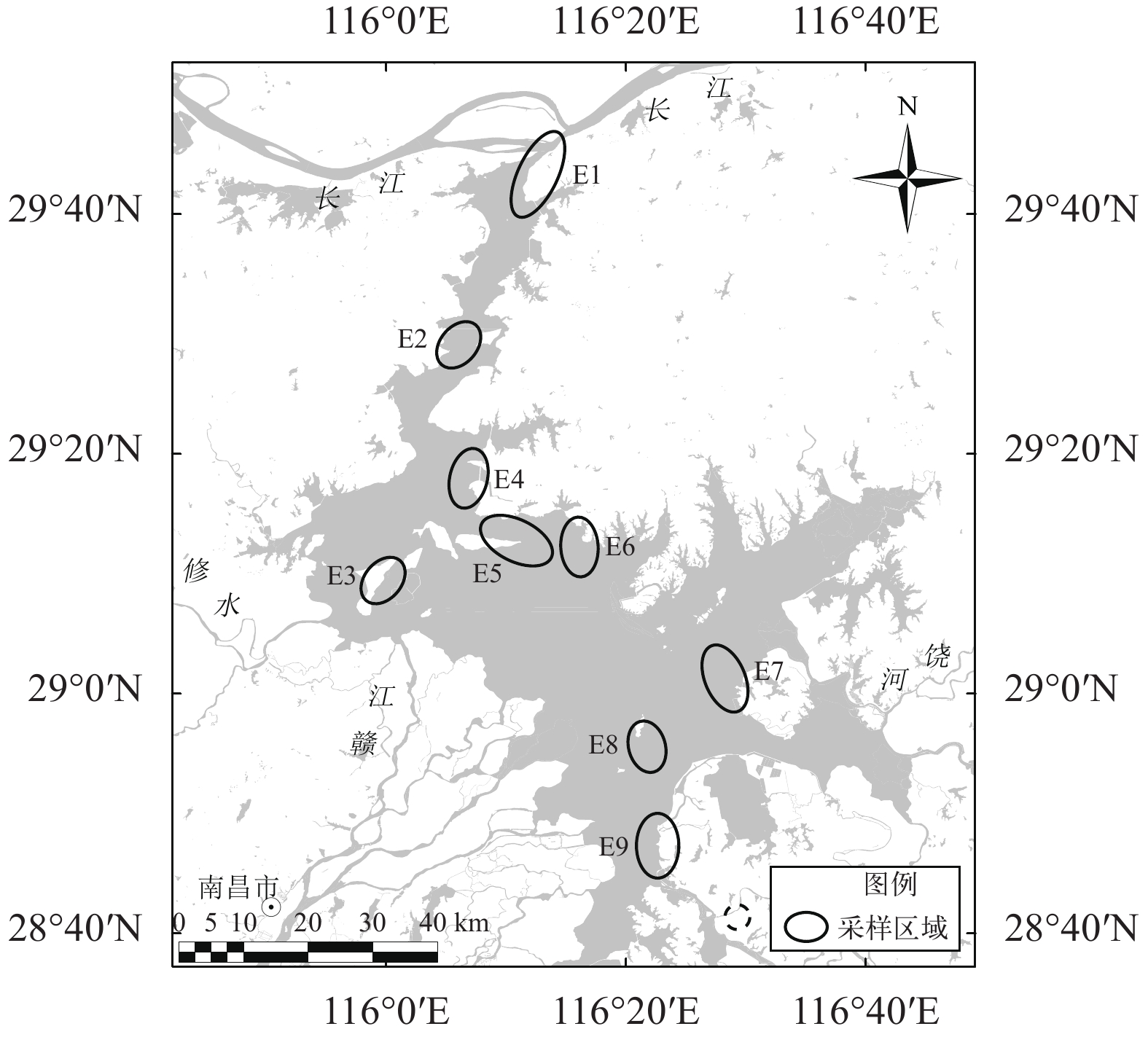
 下载:
下载:

